width MAZDA MODEL CX-7 2012 Owners Manual (in English)
[x] Cancel search | Manufacturer: MAZDA, Model Year: 2012, Model line: MODEL CX-7, Model: MAZDA MODEL CX-7 2012Pages: 522, PDF Size: 8.79 MB
Page 28 of 522
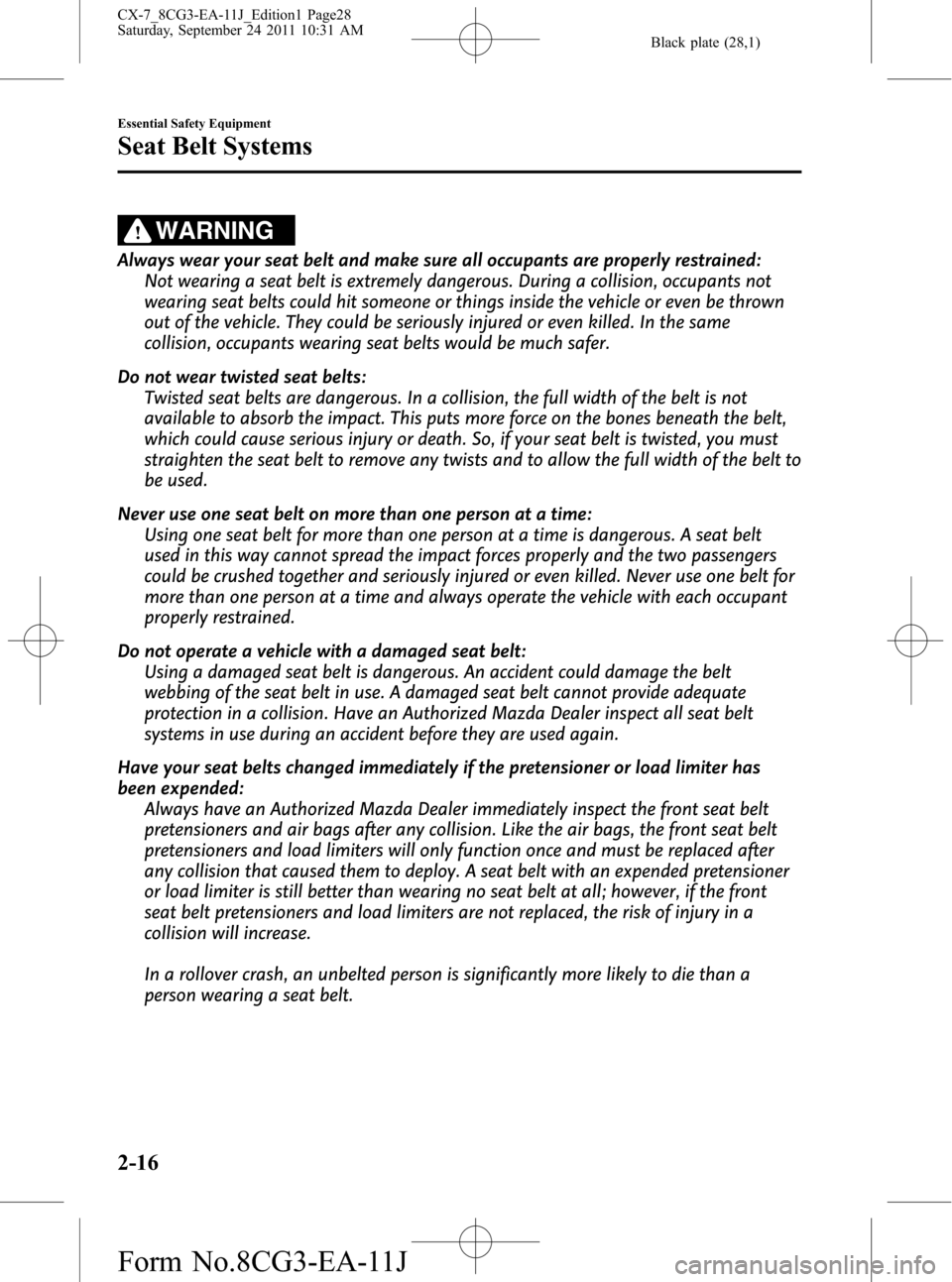
Black plate (28,1)
WARNING
Always wear your seat belt and make sure all occupants are properly restrained:
Not wearing a seat belt is extremely dangerous. During a collision, occupants not
wearing seat belts could hit someone or things inside the vehicle or even be thrown
out of the vehicle. They could be seriously injured or even killed. In the same
collision, occupants wearing seat belts would be much safer.
Do not wear twisted seat belts:
Twisted seat belts are dangerous. In a collision, the full width of the belt is not
available to absorb the impact. This puts more force on the bones beneath the belt,
which could cause serious injury or death. So, if your seat belt is twisted, you must
straighten the seat belt to remove any twists and to allow the full width of the belt to
be used.
Never use one seat belt on more than one person at a time:
Using one seat belt for more than one person at a time is dangerous. A seat belt
used in this way cannot spread the impact forces properly and the two passengers
could be crushed together and seriously injured or even killed. Never use one belt for
more than one person at a time and always operate the vehicle with each occupant
properly restrained.
Do not operate a vehicle with a damaged seat belt:
Using a damaged seat belt is dangerous. An accident could damage the belt
webbing of the seat belt in use. A damaged seat belt cannot provide adequate
protection in a collision. Have an Authorized Mazda Dealer inspect all seat belt
systems in use during an accident before they are used again.
Have your seat belts changed immediately if the pretensioner or load limiter has
been expended:
Always have an Authorized Mazda Dealer immediately inspect the front seat belt
pretensioners and air bags after any collision. Like the air bags, the front seat belt
pretensioners and load limiters will only function once and must be replaced after
any collision that caused them to deploy. A seat belt with an expended pretensioner
or load limiter is still better than wearing no seat belt at all; however, if the front
seat belt pretensioners and load limiters are not replaced, the risk of injury in a
collision will increase.
In a rollover crash, an unbelted person is significantly more likely to die than a
person wearing a seat belt.
2-16
Essential Safety Equipment
Seat Belt Systems
CX-7_8CG3-EA-11J_Edition1 Page28
Saturday, September 24 2011 10:31 AM
Form No.8CG3-EA-11J
Page 196 of 522
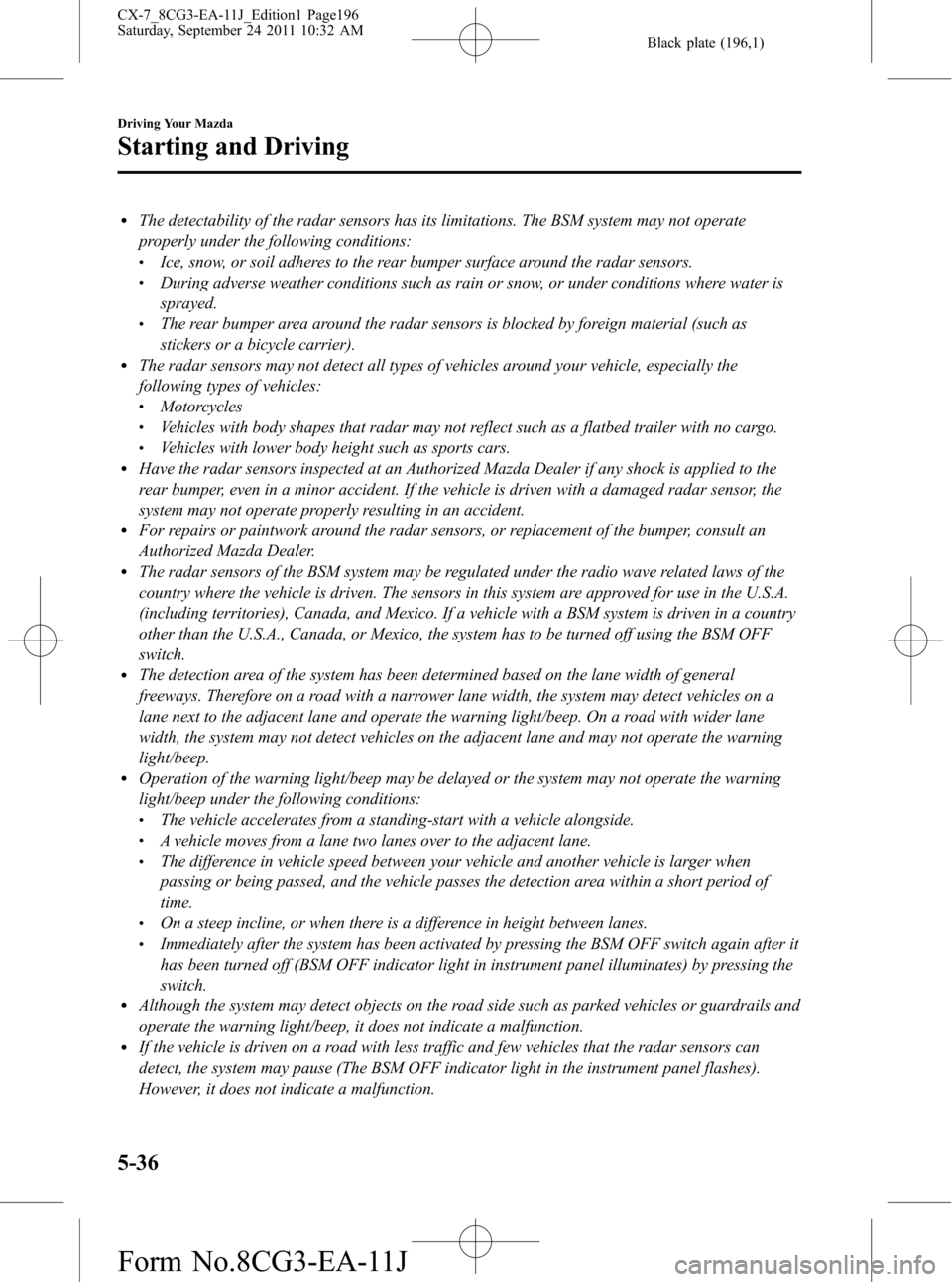
Black plate (196,1)
lThe detectability of the radar sensors has its limitations. The BSM system may not operate
properly under the following conditions:
lIce, snow, or soil adheres to the rear bumper surface around the radar sensors.lDuring adverse weather conditions such as rain or snow, or under conditions where water is
sprayed.
lThe rear bumper area around the radar sensors is blocked by foreign material (such as
stickers or a bicycle carrier).
lThe radar sensors may not detect all types of vehicles around your vehicle, especially the
following types of vehicles:
lMotorcycleslVehicles with body shapes that radar may not reflect such as a flatbed trailer with no cargo.lVehicles with lower body height such as sports cars.lHave the radar sensors inspected at an Authorized Mazda Dealer if any shock is applied to the
rear bumper, even in a minor accident. If the vehicle is driven with a damaged radar sensor, the
system may not operate properly resulting in an accident.
lFor repairs or paintwork around the radar sensors, or replacement of the bumper, consult an
Authorized Mazda Dealer.
lThe radar sensors of the BSM system may be regulated under the radio wave related laws of the
country where the vehicle is driven. The sensors in this system are approved for use in the U.S.A.
(including territories), Canada, and Mexico. If a vehicle with a BSM system is driven in a country
other than the U.S.A., Canada, or Mexico, the system has to be turned off using the BSM OFF
switch.
lThe detection area of the system has been determined based on the lane width of general
freeways. Therefore on a road with a narrower lane width, the system may detect vehicles on a
lane next to the adjacent lane and operate the warning light/beep. On a road with wider lane
width, the system may not detect vehicles on the adjacent lane and may not operate the warning
light/beep.
lOperation of the warning light/beep may be delayed or the system may not operate the warning
light/beep under the following conditions:
lThe vehicle accelerates from a standing-start with a vehicle alongside.lA vehicle moves from a lane two lanes over to the adjacent lane.lThe difference in vehicle speed between your vehicle and another vehicle is larger when
passing or being passed, and the vehicle passes the detection area within a short period of
time.
lOn a steep incline, or when there is a difference in height between lanes.lImmediately after the system has been activated by pressing the BSM OFF switch again after it
has been turned off (BSM OFF indicator light in instrument panel illuminates) by pressing the
switch.
lAlthough the system may detect objects on the road side such as parked vehicles or guardrails and
operate the warning light/beep, it does not indicate a malfunction.
lIf the vehicle is driven on a road with less traffic and few vehicles that the radar sensors can
detect, the system may pause (The BSM OFF indicator light in the instrument panel flashes).
However, it does not indicate a malfunction.
5-36
Driving Your Mazda
Starting and Driving
CX-7_8CG3-EA-11J_Edition1 Page196
Saturday, September 24 2011 10:32 AM
Form No.8CG3-EA-11J
Page 199 of 522
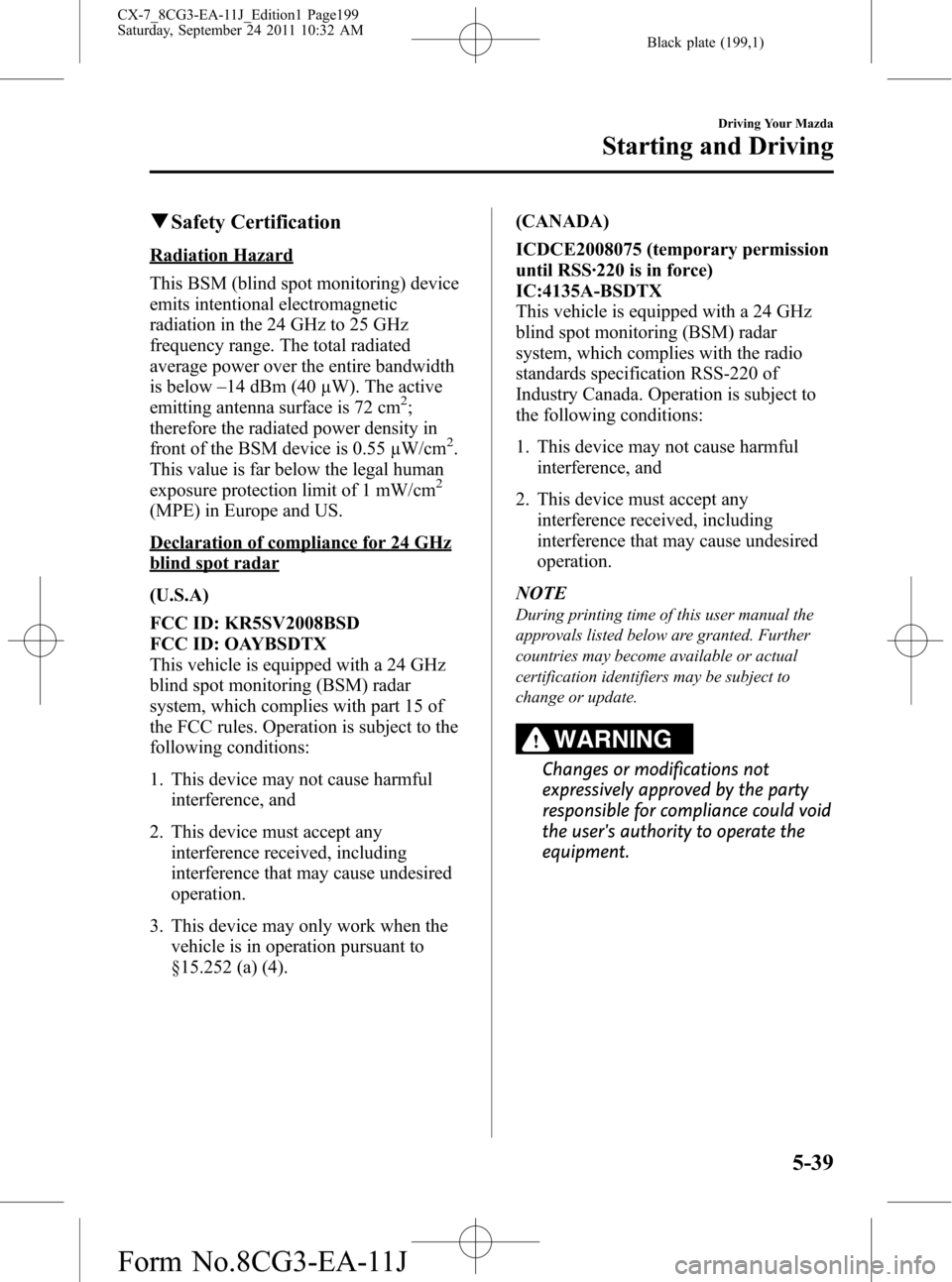
Black plate (199,1)
qSafety Certification
Radiation Hazard
This BSM (blind spot monitoring) device
emits intentional electromagnetic
radiation in the 24 GHz to 25 GHz
frequency range. The total radiated
average power over the entire bandwidth
is below_
14 dBm (40 µW). The active
emitting antenna surface is 72 cm
2;
therefore the radiated power density in
front of the BSM device is 0.55 µW/cm
2.
This value is far below the legal human
exposure protection limit of 1 mW/cm
2
(MPE) in Europe and US.
Declaration of compliance for 24 GHz
blind spot radar
(U.S.A)
FCC ID: KR5SV2008BSD
FCC ID: OAYBSDTX
This vehicle is equipped with a 24 GHz
blind spot monitoring (BSM) radar
system, which complies with part 15 of
the FCC rules. Operation is subject to the
following conditions:
1. This device may not cause harmful
interference, and
2. This device must accept any
interference received, including
interference that may cause undesired
operation.
3. This device may only work when the
vehicle is in operation pursuant to
§15.252 (a) (4).(CANADA)
ICDCE2008075 (temporary permission
until RSS·220 is in force)
IC:4135A-BSDTX
This vehicle is equipped with a 24 GHz
blind spot monitoring (BSM) radar
system, which complies with the radio
standards specification RSS-220 of
Industry Canada. Operation is subject to
the following conditions:
1. This device may not cause harmful
interference, and
2. This device must accept any
interference received, including
interference that may cause undesired
operation.
NOTE
During printing time of this user manual the
approvals listed below are granted. Further
countries may become available or actual
certification identifiers may be subject to
change or update.
WARNING
Changes or modifications not
expressively approved by the party
responsible for compliance could void
the user's authority to operate the
equipment.
Driving Your Mazda
Starting and Driving
5-39
CX-7_8CG3-EA-11J_Edition1 Page199
Saturday, September 24 2011 10:32 AM
Form No.8CG3-EA-11J
Page 433 of 522
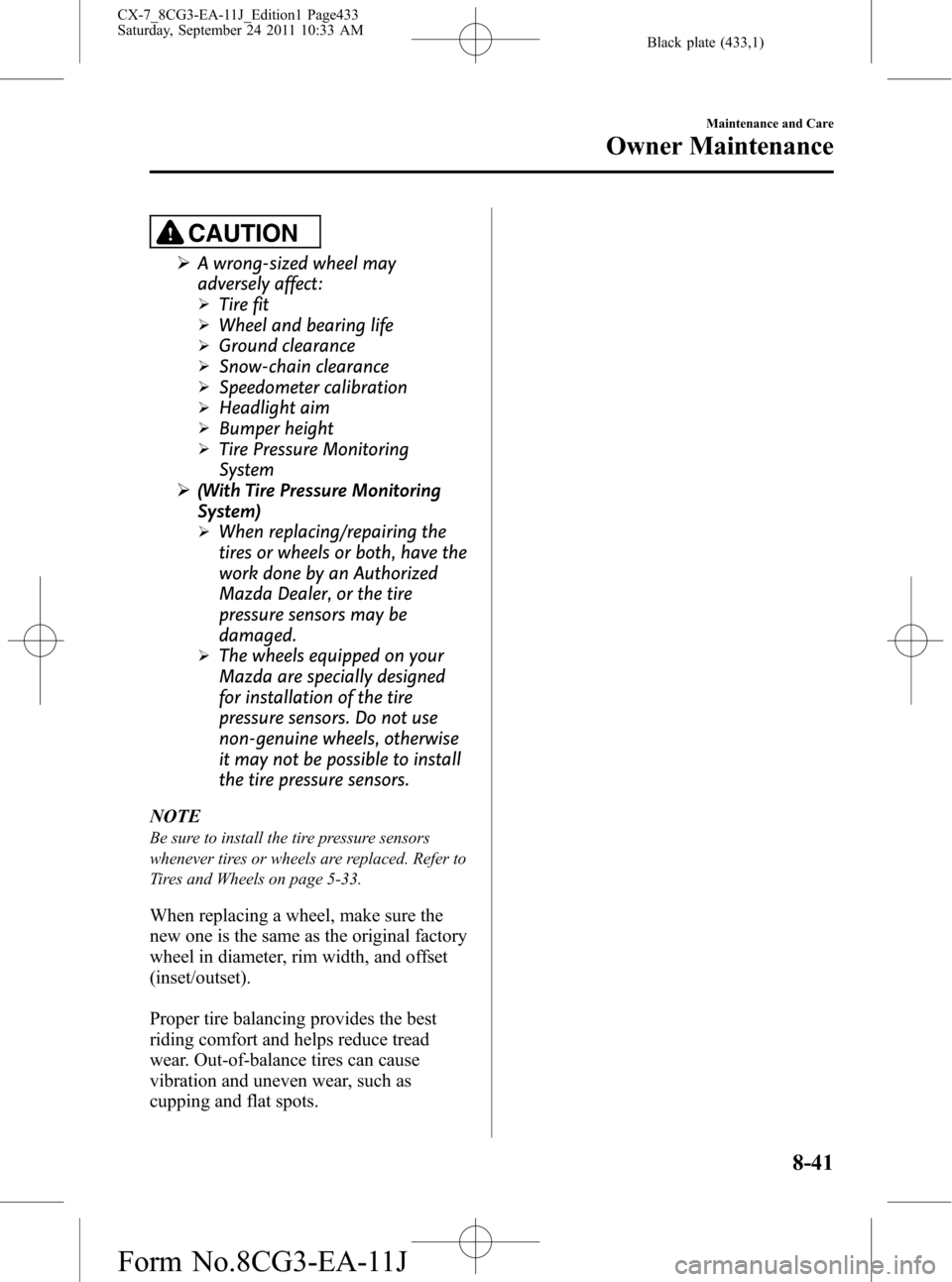
Black plate (433,1)
CAUTION
ØA wrong-sized wheel may
adversely affect:
ØTire fit
ØWheel and bearing life
ØGround clearance
ØSnow-chain clearance
ØSpeedometer calibration
ØHeadlight aim
ØBumper height
ØTire Pressure Monitoring
System
Ø(With Tire Pressure Monitoring
System)
ØWhen replacing/repairing the
tires or wheels or both, have the
work done by an Authorized
Mazda Dealer, or the tire
pressure sensors may be
damaged.
ØThe wheels equipped on your
Mazda are specially designed
for installation of the tire
pressure sensors. Do not use
non-genuine wheels, otherwise
it may not be possible to install
the tire pressure sensors.
NOTE
Be sure to install the tire pressure sensors
whenever tires or wheels are replaced. Refer to
Tires and Wheels on page 5-33.
When replacing a wheel, make sure the
new one is the same as the original factory
wheel in diameter, rim width, and offset
(inset/outset).
Proper tire balancing provides the best
riding comfort and helps reduce tread
wear. Out-of-balance tires can cause
vibration and uneven wear, such as
cupping and flat spots.
Maintenance and Care
Owner Maintenance
8-41
CX-7_8CG3-EA-11J_Edition1 Page433
Saturday, September 24 2011 10:33 AM
Form No.8CG3-EA-11J
Page 481 of 522
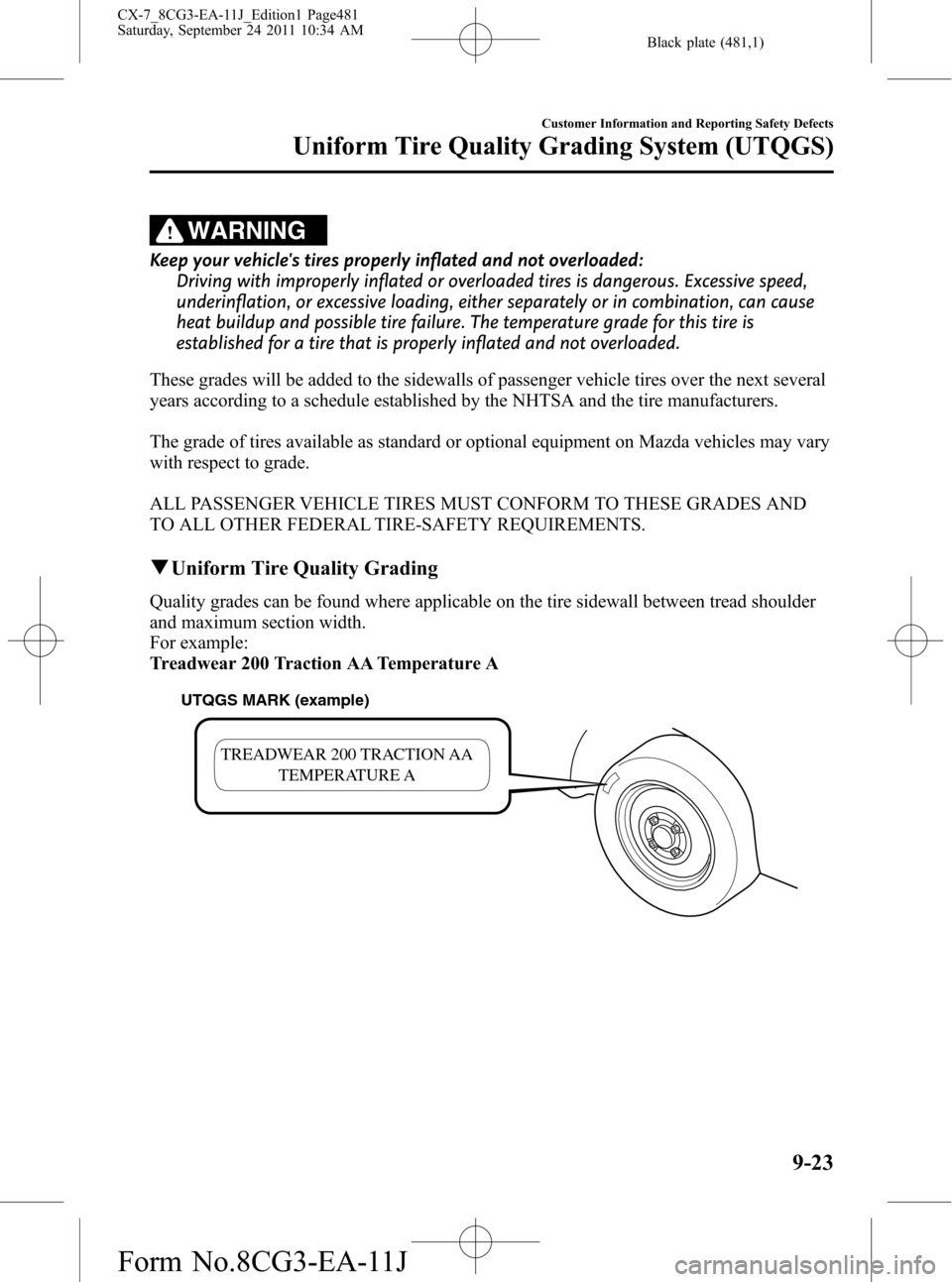
Black plate (481,1)
WARNING
Keep your vehicle's tires properly inflated and not overloaded:
Driving with improperly inflated or overloaded tires is dangerous. Excessive speed,
underinflation, or excessive loading, either separately or in combination, can cause
heat buildup and possible tire failure. The temperature grade for this tire is
established for a tire that is properly inflated and not overloaded.
These grades will be added to the sidewalls of passenger vehicle tires over the next several
years according to a schedule established by the NHTSA and the tire manufacturers.
The grade of tires available as standard or optional equipment on Mazda vehicles may vary
with respect to grade.
ALL PASSENGER VEHICLE TIRES MUST CONFORM TO THESE GRADES AND
TO ALL OTHER FEDERAL TIRE-SAFETY REQUIREMENTS.
qUniform Tire Quality Grading
Quality grades can be found where applicable on the tire sidewall between tread shoulder
and maximum section width.
For example:
Treadwear 200 Traction AA Temperature A
TREADWEAR 200 TRACTION AA
TEMPERATURE A
UTQGS MARK (example)
Customer Information and Reporting Safety Defects
Uniform Tire Quality Grading System (UTQGS)
9-23
CX-7_8CG3-EA-11J_Edition1 Page481
Saturday, September 24 2011 10:34 AM
Form No.8CG3-EA-11J
Page 482 of 522
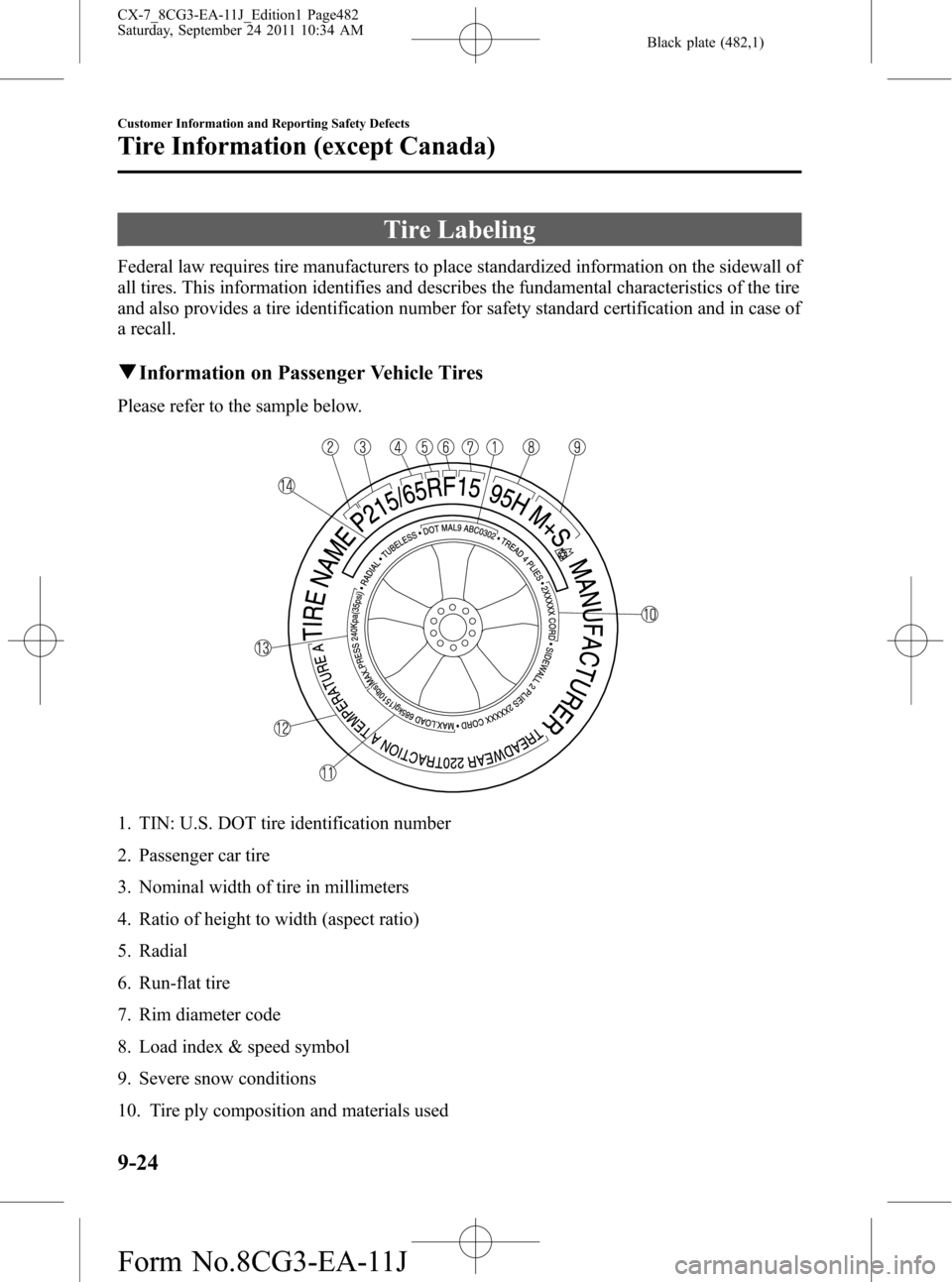
Black plate (482,1)
Tire Labeling
Federal law requires tire manufacturers to place standardized information on the sidewall of
all tires. This information identifies and describes the fundamental characteristics of the tire
and also provides a tire identification number for safety standard certification and in case of
a recall.
qInformation on Passenger Vehicle Tires
Please refer to the sample below.
1. TIN: U.S. DOT tire identification number
2. Passenger car tire
3. Nominal width of tire in millimeters
4. Ratio of height to width (aspect ratio)
5. Radial
6. Run-flat tire
7. Rim diameter code
8. Load index & speed symbol
9. Severe snow conditions
10. Tire ply composition and materials used
9-24
Customer Information and Reporting Safety Defects
Tire Information (except Canada)
CX-7_8CG3-EA-11J_Edition1 Page482
Saturday, September 24 2011 10:34 AM
Form No.8CG3-EA-11J
Page 483 of 522
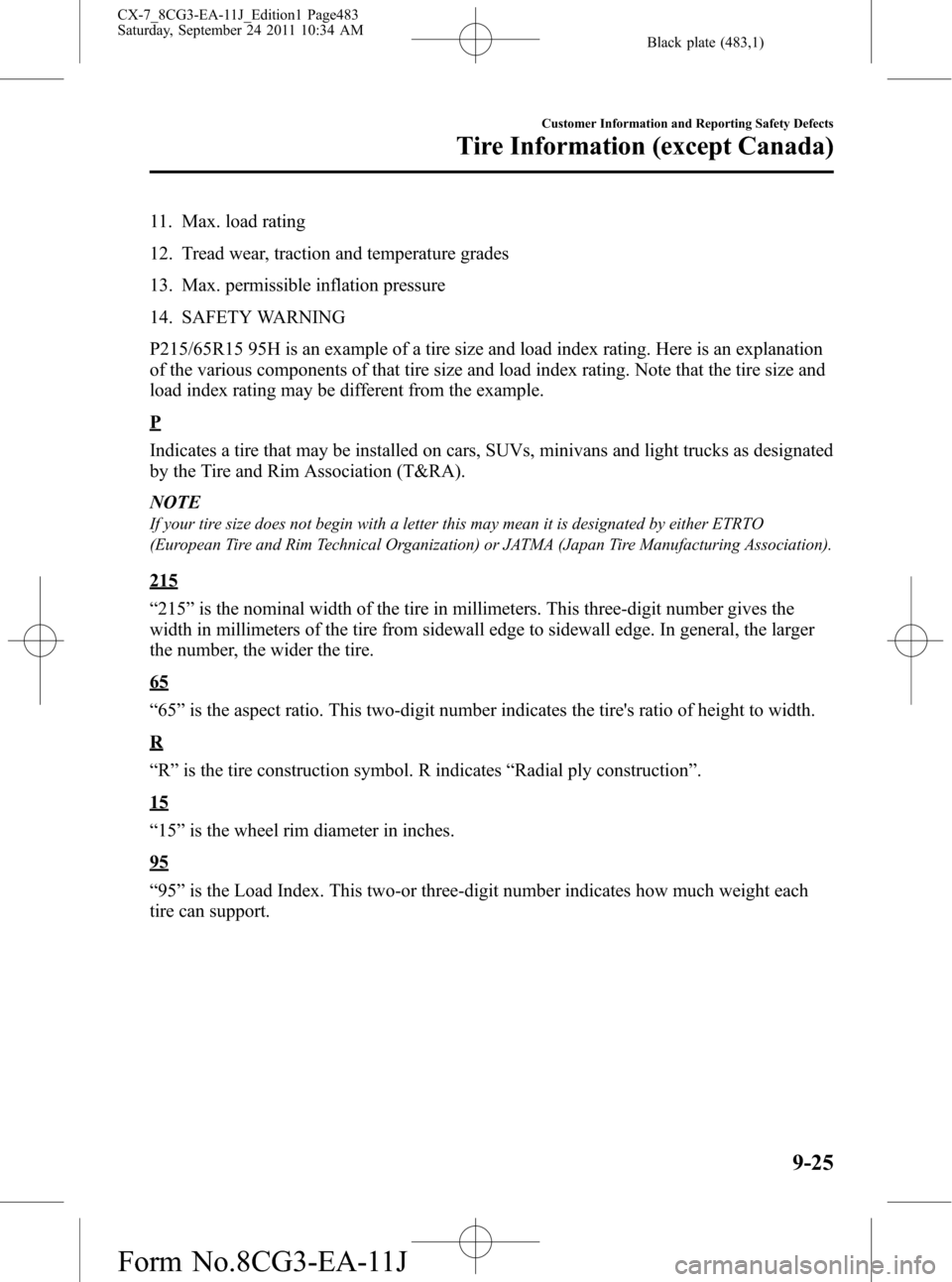
Black plate (483,1)
11. Max. load rating
12. Tread wear, traction and temperature grades
13. Max. permissible inflation pressure
14. SAFETY WARNING
P215/65R15 95H is an example of a tire size and load index rating. Here is an explanation
of the various components of that tire size and load index rating. Note that the tire size and
load index rating may be different from the example.
P
Indicates a tire that may be installed on cars, SUVs, minivans and light trucks as designated
by the Tire and Rim Association (T&RA).
NOTE
If your tire size does not begin with a letter this may mean it is designated by either ETRTO
(European Tire and Rim Technical Organization) or JATMA (Japan Tire Manufacturing Association).
215
“215”is the nominal width of the tire in millimeters. This three-digit number gives the
width in millimeters of the tire from sidewall edge to sidewall edge. In general, the larger
the number, the wider the tire.
65
“65”is the aspect ratio. This two-digit number indicates the tire's ratio of height to width.
R
“R”is the tire construction symbol. R indicates“Radial ply construction”.
15
“15”is the wheel rim diameter in inches.
95
“95”is the Load Index. This two-or three-digit number indicates how much weight each
tire can support.
Customer Information and Reporting Safety Defects
Tire Information (except Canada)
9-25
CX-7_8CG3-EA-11J_Edition1 Page483
Saturday, September 24 2011 10:34 AM
Form No.8CG3-EA-11J
Page 486 of 522
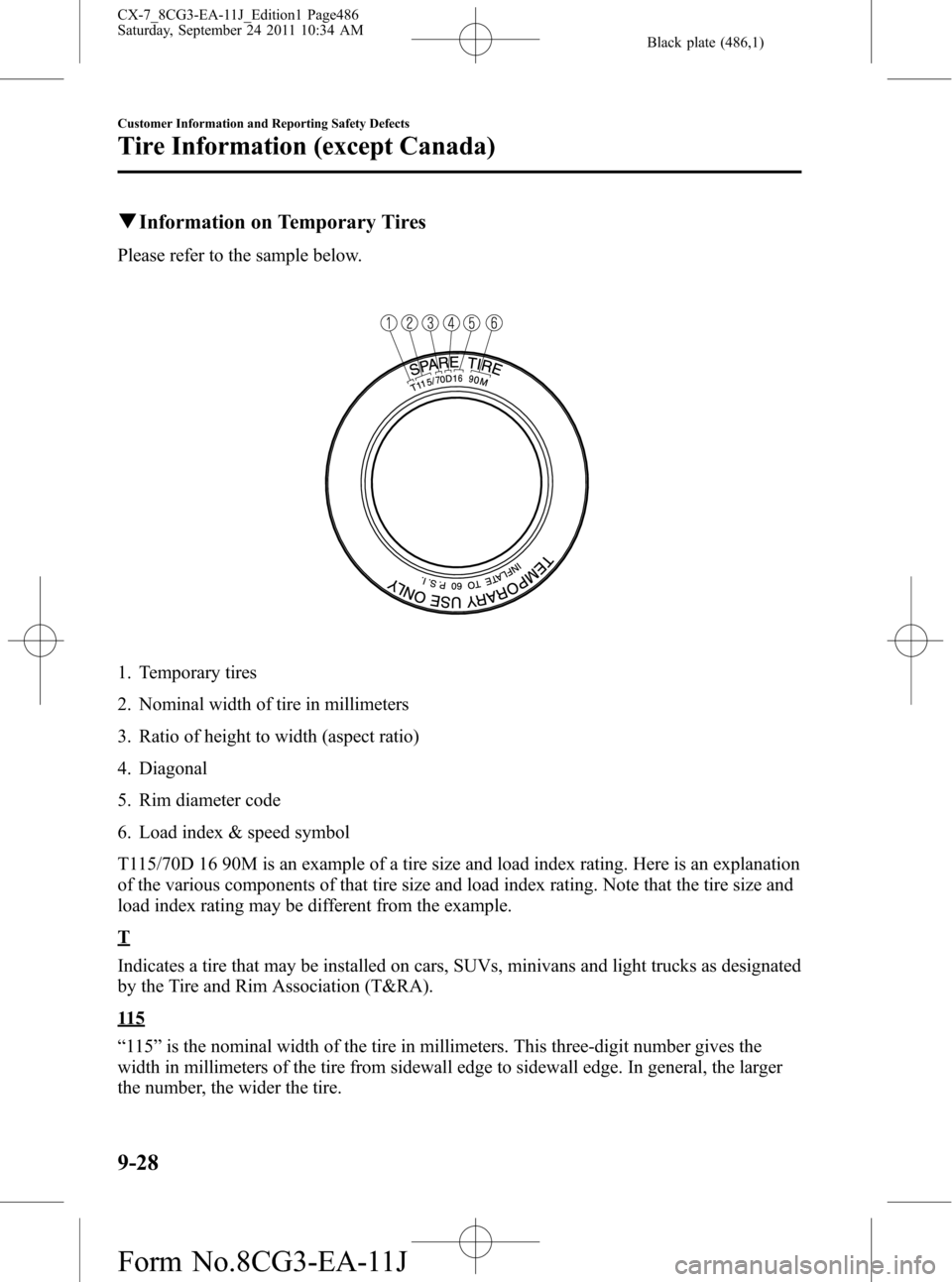
Black plate (486,1)
qInformation on Temporary Tires
Please refer to the sample below.
1. Temporary tires
2. Nominal width of tire in millimeters
3. Ratio of height to width (aspect ratio)
4. Diagonal
5. Rim diameter code
6. Load index & speed symbol
T115/70D 16 90M is an example of a tire size and load index rating. Here is an explanation
of the various components of that tire size and load index rating. Note that the tire size and
load index rating may be different from the example.
T
Indicates a tire that may be installed on cars, SUVs, minivans and light trucks as designated
by the Tire and Rim Association (T&RA).
11 5
“115”is the nominal width of the tire in millimeters. This three-digit number gives the
width in millimeters of the tire from sidewall edge to sidewall edge. In general, the larger
the number, the wider the tire.
9-28
Customer Information and Reporting Safety Defects
Tire Information (except Canada)
CX-7_8CG3-EA-11J_Edition1 Page486
Saturday, September 24 2011 10:34 AM
Form No.8CG3-EA-11J
Page 487 of 522
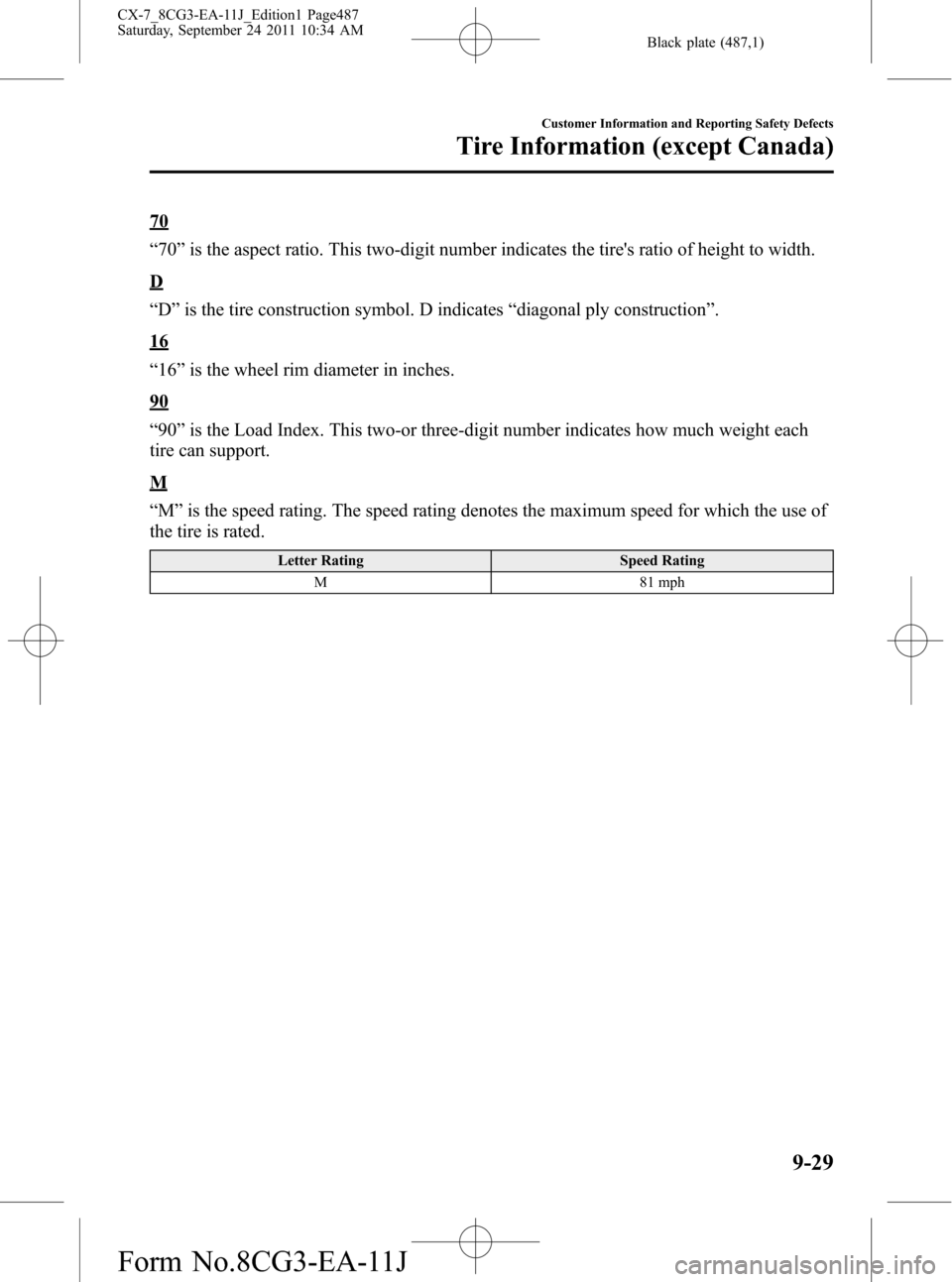
Black plate (487,1)
70
“70”is the aspect ratio. This two-digit number indicates the tire's ratio of height to width.
D
“D”is the tire construction symbol. D indicates“diagonal ply construction”.
16
“16”is the wheel rim diameter in inches.
90
“90”is the Load Index. This two-or three-digit number indicates how much weight each
tire can support.
M
“M”is the speed rating. The speed rating denotes the maximum speed for which the use of
the tire is rated.
Letter Rating Speed Rating
M 81 mph
Customer Information and Reporting Safety Defects
Tire Information (except Canada)
9-29
CX-7_8CG3-EA-11J_Edition1 Page487
Saturday, September 24 2011 10:34 AM
Form No.8CG3-EA-11J
Page 511 of 522
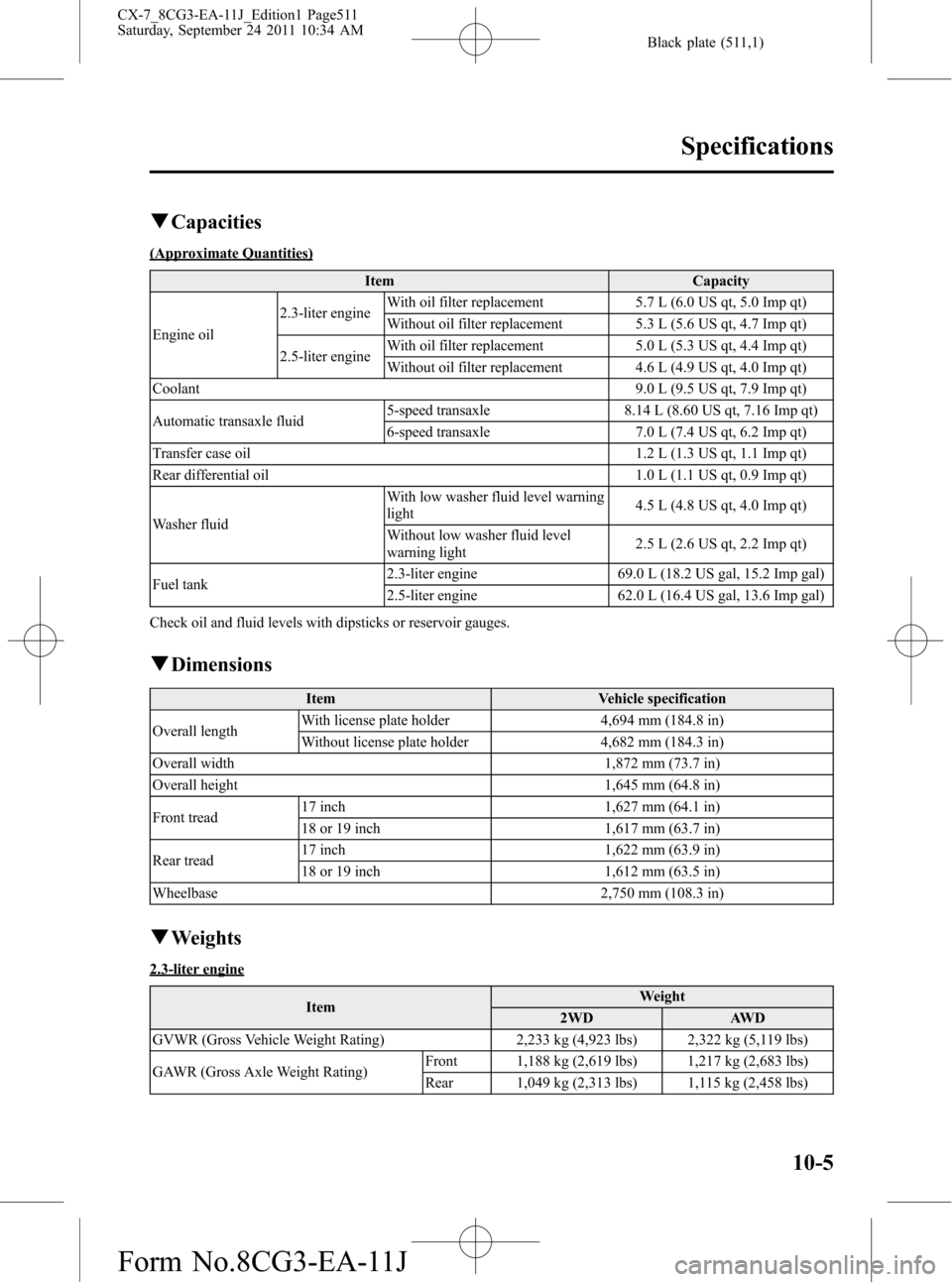
Black plate (511,1)
qCapacities
(Approximate Quantities)
Item Capacity
Engine oil2.3-liter engineWith oil filter replacement 5.7 L (6.0 US qt, 5.0 Imp qt)
Without oil filter replacement 5.3 L (5.6 US qt, 4.7 Imp qt)
2.5-liter engineWith oil filter replacement 5.0 L (5.3 US qt, 4.4 Imp qt)
Without oil filter replacement 4.6 L (4.9 US qt, 4.0 Imp qt)
Coolant 9.0 L (9.5 US qt, 7.9 Imp qt)
Automatic transaxle fluid5-speed transaxle 8.14 L (8.60 US qt, 7.16 Imp qt)
6-speed transaxle 7.0 L (7.4 US qt, 6.2 Imp qt)
Transfer case oil 1.2 L (1.3 US qt, 1.1 Imp qt)
Rear differential oil 1.0 L (1.1 US qt, 0.9 Imp qt)
Washer fluidWith low washer fluid level warning
light4.5 L (4.8 US qt, 4.0 Imp qt)
Without low washer fluid level
warning light2.5 L (2.6 US qt, 2.2 Imp qt)
Fuel tank2.3-liter engine 69.0 L (18.2 US gal, 15.2 Imp gal)
2.5-liter engine 62.0 L (16.4 US gal, 13.6 Imp gal)
Check oil and fluid levels with dipsticks or reservoir gauges.
qDimensions
Item Vehicle specification
Overall lengthWith license plate holder 4,694 mm (184.8 in)
Without license plate holder 4,682 mm (184.3 in)
Overall width 1,872 mm (73.7 in)
Overall height 1,645 mm (64.8 in)
Front tread17 inch 1,627 mm (64.1 in)
18 or 19 inch 1,617 mm (63.7 in)
Rear tread17 inch 1,622 mm (63.9 in)
18 or 19 inch 1,612 mm (63.5 in)
Wheelbase 2,750 mm (108.3 in)
qWeights
2.3-liter engine
ItemWeight
2WD AWD
GVWR (Gross Vehicle Weight Rating) 2,233 kg (4,923 lbs) 2,322 kg (5,119 lbs)
GAWR (Gross Axle Weight Rating)Front 1,188 kg (2,619 lbs) 1,217 kg (2,683 lbs)
Rear 1,049 kg (2,313 lbs) 1,115 kg (2,458 lbs)
Specifications
10-5
CX-7_8CG3-EA-11J_Edition1 Page511
Saturday, September 24 2011 10:34 AM
Form No.8CG3-EA-11J